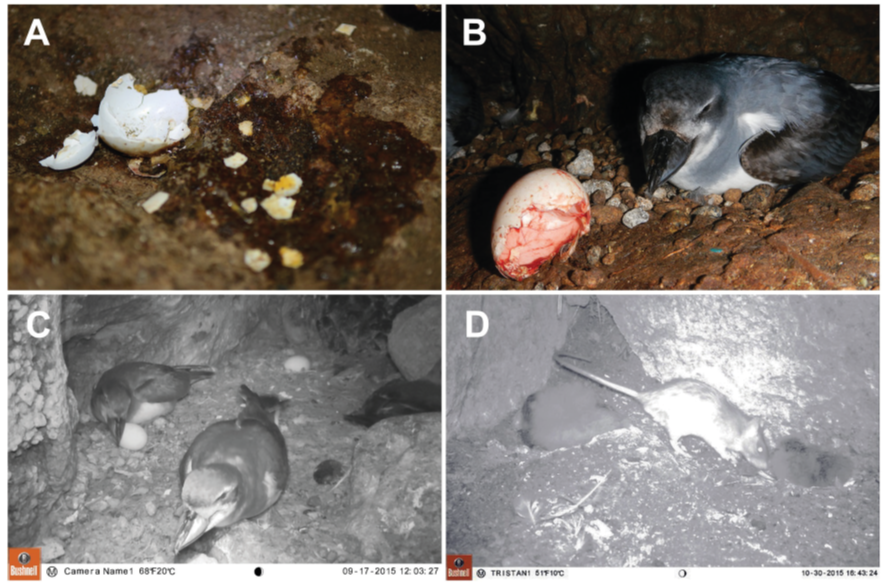
(a), (b) Broad-billed Prion eggshells with teeth marks from Black Rats in Hillpiece Cave, Tristan da Cunha, (c) incubating prions, with an abandoned whole egg in the background, (d) Black Rat harassing a small prion chick (from the publication)
Ben Dilley (FitzPatrick Institute of African Ornithology, University of Cape Town, South Africa) and colleagues have published in the journal Ostrich Journal of African Ornithology on the suspected role played by rats in low breeding success of Broad-billed Prions Pachyptila vittata on Tristan da Cunha.
The paper’s abstract follows in English and French:
Tristan da Cunha is a 96 km² volcanic island in the South Atlantic Ocean. Black Rats Rattus rattus reached the island from a shipwreck in 1882 and their depredation of seabirds’ eggs and chicks are likely partly responsible for the much lower densities of burrow-nesting petrels, compared with adjacent rodent-free islands in the archipelago. We monitored a colony of Broad-billed Prions Pachyptila vittata breeding in a coastal cliff cave in 2015/2016, where a maximum of 6% of chicks survived from 310 nests. We suspect rats frequently depredated eggs (36% of eggs were found broken with rat bite marks) and infrared trail cameras recorded how rats repeatedly hassled chicks, although no direct chick depredations were recorded.
Tristan da Cunha est une île volcanique de 96 km² localisée en océan Atlantique sud. Le rat noir Rattus rattus colonisa l’île en 1882 après le naufrage d’un navire. La predation du rat sur les oeufs et oisillons d’oiseaux marins est très probablement responsable de la très faible densité de Procellariidées nichant en terrier comparé à d’autres îles dépouvues du rongeur au sein de l’archipel. Nous avons suivi une colonie de Prion de Forster Pachyptila vittata nichant sur une falaise cotière au sein d’une grotte en 2015/2016. Seulement 6% des oisillons survécurent sur les 310 nids suivis. Nous suspectons que les rats prédatent fréquemment les oeufs (36% des oeufs ont été retrouvés cassés avec des traces de morsures de rats). Aussi, les cameras infrarouge sur les sentiers ont enregistré une incessante aggression des rats sur les oisillons, bien qu’aucune predation directe ne fut enregistrée.”
Although a draft operational plan to eradicate Tristan’s rodents was produced in 2007, there are apparently no current plans to eradicate them. However, local control of rodents utilizing bait stations occurs in inhabited and cultivated areas. In contrast, an attempt to eradicate introduced House Mice on Gough Island, part of the Tristan da Cunha group of islands, is set to occur this austral winter (click here).
With thanks to Ben Dilley.
References:
Brown, D. 2007. Preliminary Operational Plan for Rodent Eradication from Tristan da Cunha. Unpublished Report to the Royal Society for the Protection of Birds. Sandy: Royal Society for the Protection of Birds. 115 pp.
Dilley, B.J., Davies, D., Repetto, J., Swain, G. & Ryan, P.G. 2020. Rats and prions at Tristan da Cunha Island. Ostrich 91(3).
John Cooper, ACAP Information Officer, 14 April 2021

 Español
Español  English
English  Français
Français